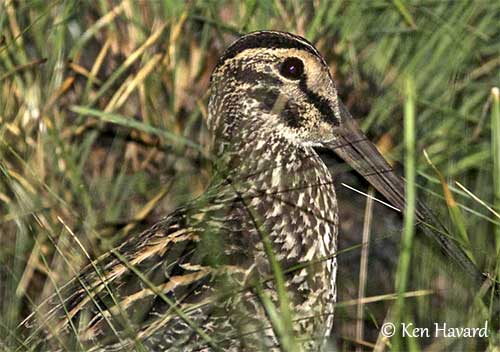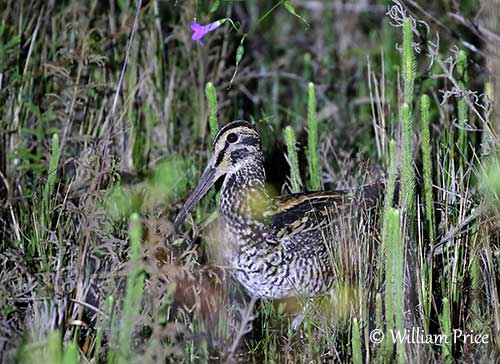
The Giant Snipe probably displays at night. The other Gallinago species perform aerial displays during which the bird flies high in circles, followed by a powerful stoop with the tail feathers producing a drumming sound. But it is not known whether it drums.
The Giant Snipe is known arriving seasonally, mainly after rains, at some sites. However, there is no information on short-distance movements.
The flight is probably similar to other snipes, and well-adapted to the nocturnal life.
REPRODUCTION OF THIS SPECIES:
From observation of nests placed on a hillock in marshy area, the Giant Snipe of the southern race G.u. gigantea breeds in September and from November to January in Brazil. The nests contained 2-4 pale buff eggs with brown spots. They were in a shallow depression on the ground, lined with dry grasses. The nest is usually well-hidden among the vegetation.
The chicks are black with fine white spotting.
PROTECTION / THREATS / STATUS:
The Giant Snipe is vulnerable to hunting pressure throughout most of the range, but habitat loss in some regions is also a problem.
This species is described as local and uncommon, but both secretive behaviour and nocturnal habits make it difficult to observe.
The population is suspected to be decreasing, but more information is needed.
The Giant Snipe is not considered globally threatened, and the species is currently evaluated as Least Concern.
Fr: Bécassine géante
Ang: Giant Snipe
All: Riesenbekassine
Esp: Agachadiza Gigante
Ita: Beccaccino gigante
Nd: Reuzensnip
Sd: jättebeckasin
Photographers:
Ken Havard
My Bird Gallery & Flickr gallery 1 & Flickr gallery 2
William Price
PBase-tereksandpiper & Flickr William Price
Text by Nicole Bouglouan
Sources:
HANDBOOK OF THE BIRDS OF THE WORLD Vol 3 by Josep del Hoyo-Andrew Elliott-Jordi Sargatal - Lynx Edicions - ISBN: 8487334202
SHOREBIRDS by Peter Hayman, John Marchant and Tony Prater – Christopher Helm – 1986 – ISBN: 0747014035
BIRDS OF VENEZUELA by Steven L. Hilty – Ed. Christopher Helm – ISBN: 0713664185
A GUIDE TO THE BIRDS OF COLOMBIA by Steven L. Hilty and William L. Brown - Princeton University Press – ISBN 069108372X
Wikipedia, the free encyclopaedia
Wikipedia, la enciclopedia libre
Neotropical Birds – Cornell Lab of Ornithology
Giant Snipe
Gallinago undulata
Charadriiformes Order – Scolopacidae Family
INTRODUCTION:
The Giant Snipe is a stocky wader, the largest of all the Gallinago species. This South American species has two subspecies sharing the highly fragmented range.
It frequents the tall, dense, swampy vegetation, the wet pastures and the flooded grasslands, although it is not always near water and can be seen at high elevations.
The Giant Snipe has mainly crepuscular and nocturnal habits, making it very difficult to observe. This species is relatively poorly known.
The Giant Snipe is vulnerable to hunting pressure because it is easier to shoot than other snipes thanks to its large size. Habitat loss is probably a threat too. The population is suspected to be decreasing, but currently, it is not considered globally threatened.
DESCRIPTION OF THE BIRD:
Biometrics:
Length: 36-47 cm
Weight: Race undulata: 270-362 g – Race gigantea: 420-500 g
The Giant Snipe has dark brown upperparts with bold blackish and chestnut/cinnamon markings, more conspicuous than other snipes. Rump and tail are pale cinnamon, but there is no white on tail sides. The flight-feathers are barred, a unique detail in snipes. The wings are broad and rounded.
On the whitish underparts, the foreneck is streaked blackish and the sides of the breast are finely barred black. Flanks are barred brown.

Like other snipes, the head shows black and pale buff/whitish stripes.
The long bill has thick base extending high on the forecrown, involving flat-headed profile. The eyes are dark brown. Legs and feet are greenish-yellow.
Male and female are similar.
The juvenile is not described, but it usually differs by pale fringes on wing-coverts.
SUBSPECIES AND RANGE:
The Giant Snipe has two subspecies.
G.u. undulata (described above) occurs in W and E Colombia, Venezuela to extreme N Brazil, and E to the Guianas.
G.u. gigantea (displayed) is found in E Bolivia, E Paraguay and SE Brazil, and probably in Uruguay and NE Argentina.
This race is larger than nominate, with more conspicuous plumage markings and broader cinnamon fringes on upperpart’s feathers.
HABITAT:
The Giant Snipe can be found in wet pastures, marshy savannas, tall vegetation in swampy areas and flooded grasslands, up to 2,200 metres of elevation. It may also occur in tall, dry grass, probably mainly for roosting.
CALLS AND SONGS: SOUNDS BY XENO-CANTO
The Giant Snipe has a rich repertoire of sounds. When the bird is flushed, it gives a disyllabic, harsh “kek-kek”. During the nocturnal aerial displays, it utters a deep “oga-gao oga-gao…” with ascending first note and descending second note. It also produces a strong “sch” during 4 seconds, fairly similar to a buzzing bee swarm. Harsh calls are also heard.
Mechanical sounds are produced by the tail feathers during the flight displays, but several sounds are often produced at the same time.
Vocalizations are usually heard at dawn and dusk, but for larger periods on moonlit nights, up to 2 hours.
BEHAVIOUR IN THE WILD:
The Giant Snipe’s behaviour is poorly known. The diet is said to include frogs, but only grasses and small fruits were found in the gizzards of specimens collected in Surinam. This solitary species is suspected to feed only at night.
